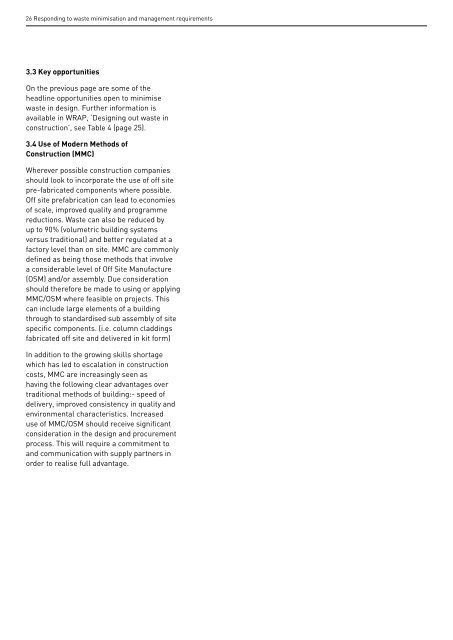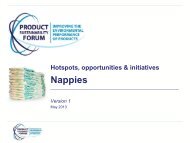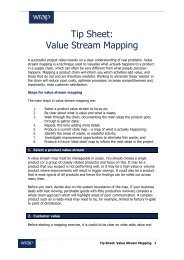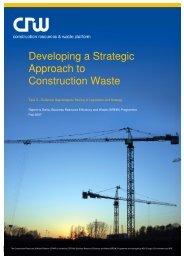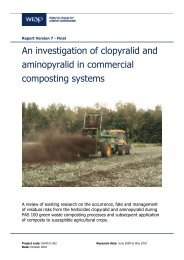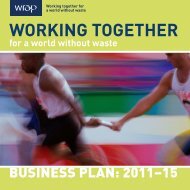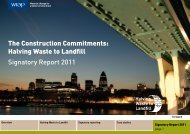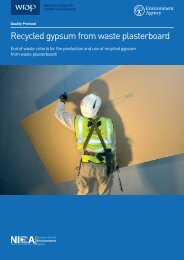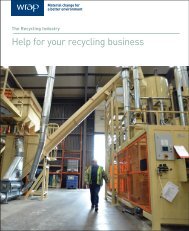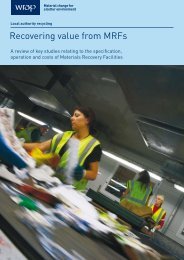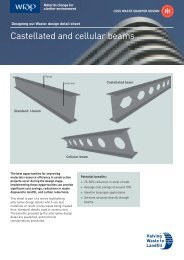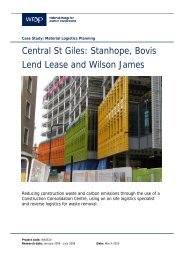Responding to waste minimisation and management ... - Wrap
Responding to waste minimisation and management ... - Wrap
Responding to waste minimisation and management ... - Wrap
You also want an ePaper? Increase the reach of your titles
YUMPU automatically turns print PDFs into web optimized ePapers that Google loves.
26 <strong>Responding</strong> <strong>to</strong> <strong>waste</strong> <strong>minimisation</strong> <strong>and</strong> <strong>management</strong> requirements <strong>Responding</strong> <strong>to</strong> <strong>waste</strong> <strong>minimisation</strong> <strong>and</strong> <strong>management</strong> requirements 27<br />
3.3 Key opportunities<br />
On the previous page are some of the<br />
headline opportunities open <strong>to</strong> minimise<br />
<strong>waste</strong> in design. Further information is<br />
available in WRAP, ‘Designing out <strong>waste</strong> in<br />
construction’, see Table 4 (page 25).<br />
3.4 Use of Modern Methods of<br />
Construction (MMC)<br />
Wherever possible construction companies<br />
should look <strong>to</strong> incorporate the use of off site<br />
pre-fabricated components where possible.<br />
Off site prefabrication can lead <strong>to</strong> economies<br />
of scale, improved quality <strong>and</strong> programme<br />
reductions. Waste can also be reduced by<br />
up <strong>to</strong> 90% (volumetric building systems<br />
versus traditional) <strong>and</strong> better regulated at a<br />
fac<strong>to</strong>ry level than on site. MMC are commonly<br />
defined as being those methods that involve<br />
a considerable level of Off Site Manufacture<br />
(OSM) <strong>and</strong>/or assembly. Due consideration<br />
should therefore be made <strong>to</strong> using or applying<br />
MMC/OSM where feasible on projects. This<br />
can include large elements of a building<br />
through <strong>to</strong> st<strong>and</strong>ardised sub assembly of site<br />
specific components. (i.e. column claddings<br />
fabricated off site <strong>and</strong> delivered in kit form)<br />
In addition <strong>to</strong> the growing skills shortage<br />
which has led <strong>to</strong> escalation in construction<br />
costs, MMC are increasingly seen as<br />
having the following clear advantages over<br />
traditional methods of building:- speed of<br />
delivery, improved consistency in quality <strong>and</strong><br />
environmental characteristics. Increased<br />
use of MMC/OSM should receive significant<br />
consideration in the design <strong>and</strong> procurement<br />
process. This will require a commitment <strong>to</strong><br />
<strong>and</strong> communication with supply partners in<br />
order <strong>to</strong> realise full advantage.<br />
Construction elements<br />
Ductwork <strong>and</strong><br />
mechanical &<br />
electrical equipment<br />
Cladding<br />
Flooring <strong>and</strong> ceilings<br />
Rooms<br />
Washrooms<br />
Kitchens<br />
Plant room<br />
Description<br />
Table 5: Examples of construction elements that typically lend themselves <strong>to</strong> Modern Methods<br />
of Construction (MMC) <strong>and</strong> Off Site Manufacturing (OSM)<br />
The WRAP document, “Current Practices<br />
<strong>and</strong> Future Potential in Modern Methods<br />
of Construction” highlights the potential<br />
of a range of off site methods <strong>to</strong> impact<br />
on <strong>waste</strong> <strong>minimisation</strong>. This is available<br />
in full <strong>and</strong> summary form at<br />
www.wrap.org.uk/construction<br />
Some projects also lend themselves more<br />
readily <strong>to</strong> the use of modern methods <strong>and</strong> the<br />
use of off site fabrication than others because<br />
of site characteristics or the nature of what is<br />
being built, see Table 5.<br />
Ductwork <strong>and</strong> M&E systems can be fabricated in a modular nature allowing it <strong>to</strong> be easily<br />
transported <strong>to</strong> site <strong>and</strong> fitted with minimal <strong>waste</strong>.<br />
Internal <strong>and</strong> external wall cladding can be fabricated in panels made <strong>to</strong> size <strong>and</strong> fitted on<br />
site. Other areas where off site fabricated cladding can be used are on internal columns,<br />
ceilings <strong>and</strong> roofs.<br />
These off site systems can be delivered <strong>to</strong> site pre-fabricated in<strong>to</strong> cassettes that can be<br />
quickly <strong>and</strong> easily fastened <strong>to</strong>gether on site.<br />
Whole volumetric rooms can be manufactured off site.<br />
These can be manufactured off site <strong>and</strong> delivered either in a 2-D or 3-D format <strong>to</strong> the site.<br />
Plumbing <strong>and</strong> other fittings are included thus minimising packaging <strong>and</strong> plumbing <strong>waste</strong>.<br />
Kitchen areas can be manufactured <strong>and</strong> delivered <strong>to</strong> site in a similar fashion <strong>to</strong> washrooms.<br />
Plant rooms can be fully fabricated <strong>and</strong> delivered as a complete package <strong>to</strong> site where they<br />
can be fitted in<strong>to</strong> position with limited disruption.<br />
Other equipment Lifts <strong>and</strong> escala<strong>to</strong>rs<br />
Pre-assembled back office equipment<br />
Pre-fabricated <strong>and</strong> assembled doors, windows <strong>and</strong> frames.


